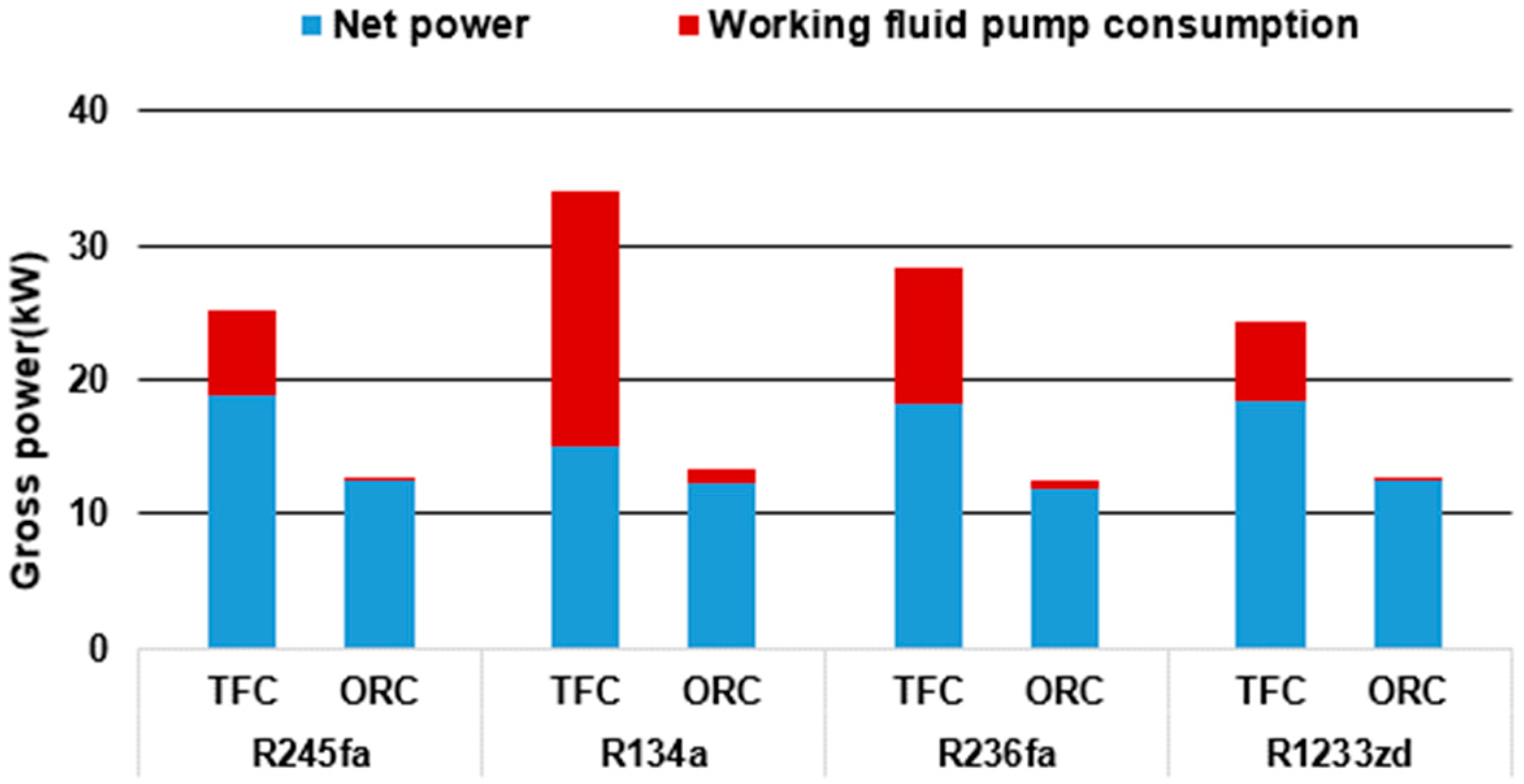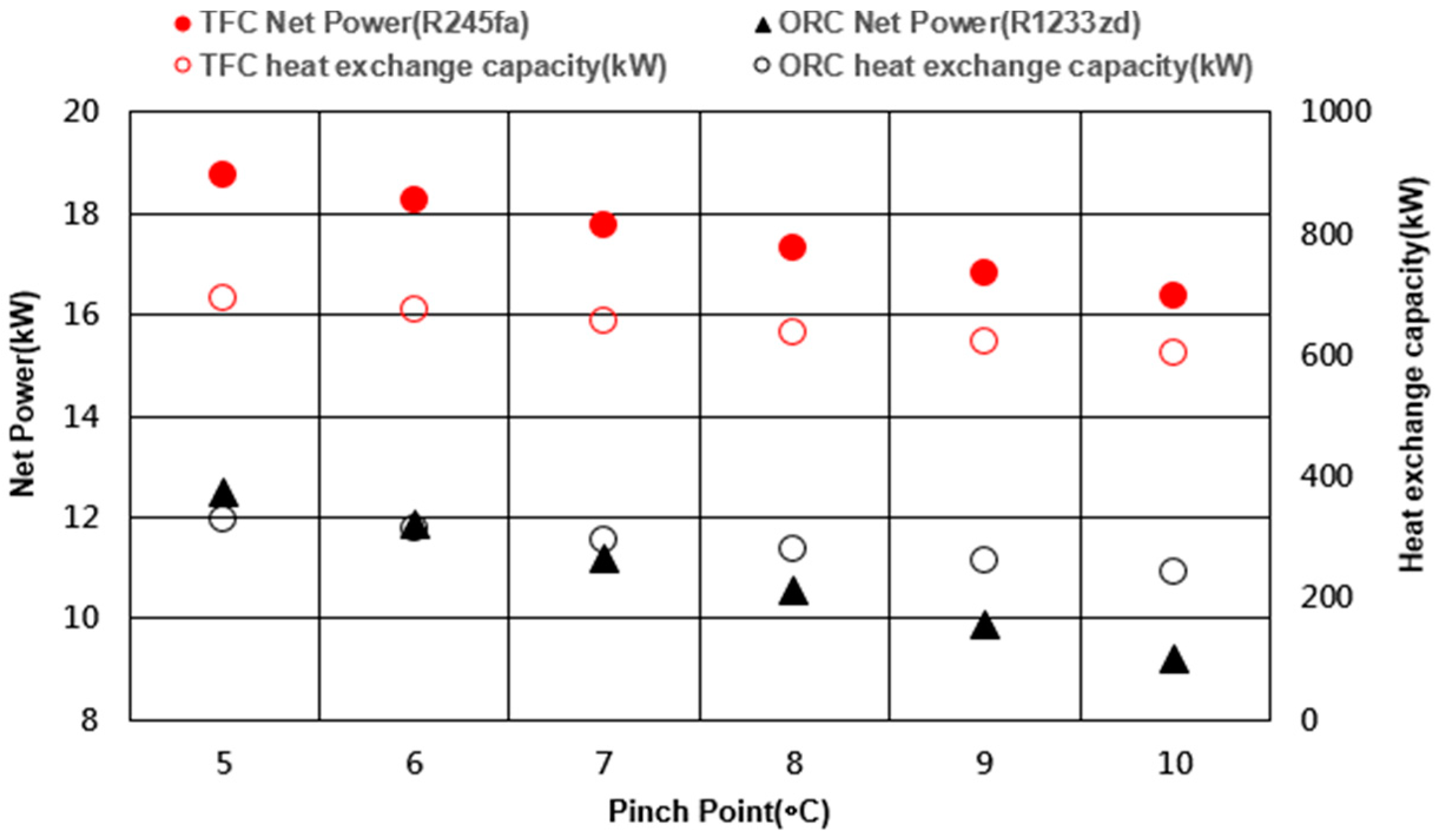Comparison of the Trilateral Flash Cycle and Rankine Cycle with Organic Fluid Using the Pinch Point Temperature
Abstract
:1. Introduction
2. Theoretical Modeling
3. Results
4. Discussion
5. Conclusions
- (1)
- The evaporation temperature influenced the net power and thermal efficiency of the TFC system. When the temperature increases, each working fluid can achieve relatively large power generation and thermal efficiency. The pinch temperature relatively limits the operating maximum temperature of the ORC system. The excessive evaporation temperature reduces the working fluid mass flow rate and system performance.
- (2)
- Under fixed environmental conditions, the increase in mass flow rate has a limit, and the mass flow rate decreases with the evaporation temperature. When the mass flow rate is higher than the optimum value, the net power generation of the system decreases. Additionally, increasing the working fluid mass flow rate only increases the net power at the minimum permissible pinch-point temperature difference and does not increase thermal efficiency. Thermal efficiency only changes with the evaporating temperature adjustment. At optimal operating conditions, the ORC system requires a lower working fluid mass flow rate than the TFC system.
- (3)
- Net power and heat transfer are negatively correlated with the pinch temperature. When the pinch point is close to the minimum temperature, more heat transfer is intercepted from the system, which can generate larger net power. The heat exchange efficiency of the ORC system is limited by the pinch point generated from the phase change of the working fluid. By contrast, the efficiency of the TFC system is relatively high because the TFC is non-isothermal and phase-unchanged, which gives it a more favorable heat extraction rate for the heat source.
- (4)
- From the simulation results, under the same heat source condition of 80 °C, the thermal efficiency of each working fluid in the ORC was compared with that in the TFC, and the TFC system exhibited a more favorable heat extraction rate and higher pump consumption, and the net power output was approximately 30% higher than the ORC system.
Author Contributions
Funding
Acknowledgments
Conflicts of Interest
References
- Forman, C.; Muritala, I.K.; Pardemann, R.; Meyer, B. Estimating the Global Waste Heat Potential. Renew. Sustain. Energy Rev. 2016, 57, 1568–1579. [Google Scholar] [CrossRef]
- Schuster, A.; Karellas, S.; Kakaras, E.; Spliethoff, H. Energetic and Economic Investigation of Organic Rankine Cycle Applications. Appl. Therm. Eng. 2009, 29, 1809–1817. [Google Scholar] [CrossRef] [Green Version]
- Fontalvo, A.; Solano, J.; Pedraza, C.; Bula, A.; Quiroga, A.G.; Padilla, R.V. Energy, Exergy and Economic Evaluation Comparison of Small-Scale Single and Dual Pressure Organic Rankine Cycles Integrated with Low-Grade Heat Sources. Entropy 2017, 19, 476. [Google Scholar] [CrossRef] [Green Version]
- Liu, B.T.; Chien, K.H.; Wang, C.H. Effect of Working Fluids on Organic Rankine Cycle for Waste Heat Recovery. Energy 2004, 29, 1207–1217. [Google Scholar] [CrossRef]
- Schroeder, D.J.; Leslie, N. Organic Rankine Cycle Working Fluid Considerations for Waste Heat to Power Applications. ASHRAE Trans. 2010, 116, 525–533. [Google Scholar]
- Wang, R.; Kuang, G.; Zhu, L.; Wang, S.; Zhao, J. Experimental Investigation of a 300 kW Organic Rankine Cycle Unit with Radial Turbine for Low-Grade Waste Heat Recovery. Entropy 2019, 21, 619. [Google Scholar] [CrossRef] [Green Version]
- Valencia, G.; Fontalvo, A.; Cárdenas, Y.; Duarte, J.; Isaza, C. Energy and Exergy Analysis of Different Exhaust Waste Heat Recovery Systems for Natural Gas Engine Based on Orc. Energies 2019, 12, 2378. [Google Scholar] [CrossRef] [Green Version]
- Hettiarachchi, H.M.; Golubovic, M.; Worek, W.M.; Ikegami, Y. Optimum Design Criteria for an Organic Rankine Cycle Using Low-Temperature Geothermal Heat Sources. Energy 2007, 32, 1698–1706. [Google Scholar] [CrossRef]
- Borsukiewicz-Gozdur, A.; Nowak, W. Maximising the Working Fluid Flow as a Way of Increasing Power Output of Geothermal Power Plant. Appl. Therm. Eng. 2007, 27, 2074–2078. [Google Scholar] [CrossRef]
- Wang, X.D.; Zhao, L.; Wang, J.L.; Zhang, W.Z.; Zhao, X.Z.; Wu, W. Performance Evaluation of a Low-Temperature Solar Rankine Cycle System Utilizing R245fa. Solar energy 2010, 84, 353–364. [Google Scholar] [CrossRef]
- Jing, L.; Gang, P.; Jie, J. Optimization of Low Temperature Solar Thermal Electric Generation with Organic Rankine Cycle in Different Areas. Appl. Energy 2010, 87, 3355–3365. [Google Scholar] [CrossRef]
- Wang, S.; Fu, Z. Thermodynamic Investigation of an Integrated Solar Combined Cycle with an Orc System. Entropy 2019, 21, 428. [Google Scholar] [CrossRef] [Green Version]
- Nguyen, T.Q.; Slawnwhite, J.D.; Boulama, K.G. Power Generation from Residual Industrial Heat. Energy Convers. Manag. 2010, 51, 2220–2229. [Google Scholar] [CrossRef]
- Olsen, D.; Abdelouadoud, Y.; Liem, P.; Wellig, B. The Role of Pinch Analysis for Industrial Orc Integration. Energy Procedia 2017, 129, 74–81. [Google Scholar] [CrossRef]
- Smith, I.K. Development of the Trilateral Flash Cycle System: Part 1: Fundamental Considerations. Proc. Inst. Mech. Eng. Part A J. Power Energy 1993, 207, 179–194. [Google Scholar] [CrossRef]
- Schuster, A.; Karellas, S.; Aumann, R. Efficiency Optimization Potential in Supercritical Organic Rankine Cycles. Energy 2010, 35, 1033–1039. [Google Scholar] [CrossRef]
- Fischer, J. Comparison of Trilateral Cycles and Organic Rankine Cycles. Energy 2011, 36, 6208–6219. [Google Scholar] [CrossRef]
- Smith, I.K.; Stosic, N.; Aldis, C. Trilateral Flash Cycle System—a High Efficiency Power Plant for Liquid Resources. In Proceedings of the World Geothermal Congress, Firenze, Italy, 18–31 May 1995; pp. 2109–2113. [Google Scholar]
- Arbab, I.M.; Sohel, R.; Mahdi, A.; Aliakbar, A. Prospects of Trilateral Flash Cycle (Tfc) for Power Generation from Low Grade Heat Sources. Presented at the E3S Web of Conferences, Berlin, Germany, 27 November 2018. [Google Scholar]
- Chen, H.; Goswami, D.Y.; Stefanakos, E.K.A. Review of Thermodynamic Cycles and Working Fluids for the Conversion of Low-Grade Heat. Renew. Sustain. Energy Rev. 2010, 14, 3059–3067. [Google Scholar] [CrossRef]
- Feng, Y.Q.; Luo, Q.H.; Wang, Q.; Wang, S.; He, Z.X.; Zhang, W.; Wang, X.; An, Q.S. Entropy and Entransy Dissipation Analysis of a Basic Organic Rankine Cycles (Orcs) to Recover Low-Grade Waste Heat Using Mixture Working Fluids. Entropy 2018, 20, 818. [Google Scholar] [CrossRef] [Green Version]
- Guo, T.; Wang, H.; Zhang, S. Comparative Analysis of Natural and Conventional Working Fluids for Use in Transcritical Rankine Cycle Using Low-Temperature Geothermal Source. Int. J. Energy Res. 2011, 35, 530–544. [Google Scholar] [CrossRef]
- Boyle, P.; Hays, L.; Kaupert, K.; Welch, P. Performance of Variable Phase Cycle in Geothermal and Waste Heat Recovery Applications. GRC Trans. 2013, 37, 679–685. [Google Scholar]
- Lecompte, S.; van den Broek, M.; de Paepe, M. Thermodynamic Analysis of the Partially Evaporating Trilateral Cycle. Presented at the 2nd International Seminar on ORC Power Systems (ASME Organic Rankine Cycle), Rotterdam, The Netherlands, 7–8 October 2013. [Google Scholar]
- Clemente, S.; Micheli, D.; Reini, M.; Taccani, R. Simulation Model of an Experimental Small-Scale Orc Cogenerator. Presented at the First International Seminar on ORC Power Systems, Delft, The Netherlands, 22–23 September 2011. [Google Scholar]
- Liu, Q.; Duan, Y.; Yang, Z. Effect of Condensation Temperature Glide on the Performance of Organic Rankine Cycles with Zeotropic Mixture Working Fluids. Appl. Energy 2014, 115, 394–404. [Google Scholar] [CrossRef]
- Lee, Y.R.; Liu, L.W.; Chang, Y.Y.; Hsieh, J.C. Development and Application of a 200 kW ORC Generator System for Energy Recovery in Chemical Processes. Energy Procedia 2017, 129, 519–526. [Google Scholar] [CrossRef]
- Trædal, S. Analysis of the Trilateral Flash Cycle for Power Production from Low Temperature Heat Sources. Master’s Thesis, Institutt for Energi-og Prosessteknikk, Kolbjørn Hejes v 1B, Trondheim, 2014. [Google Scholar]












| Parameter | Value | |
|---|---|---|
| Heat source | 80 °C Water | 4.16 kg/s |
| Heat sink | 30 °C Water | 26.6 kg/s |
| Cycle | Type | TFC, ORC |
| Working Fluid | R245fa, R134a, R236fa, R1233zd | |
| Condensation temperature | 37 °C | |
| System Componet | Pump efficiency | 0.7 |
| Expander efficiency | 0.75 | |
| Heat exchanger | Pinch temperature 5 °C | |
| Condenser | Pinch temperature 1 °C | |
| Pressure drop | No pressure drop |
| Working fluid | R245fa | R134a | R236fa | R1233zd |
|---|---|---|---|---|
| Mass flow rate(kg/sec) | 12.46 | 10.82 | 13.18 | 13.58 |
| Evaporation(°C) | 75 | 75 | 75 | 75 |
| Evaporator pressure(kPa) | 695 | 2364 | 1108 | 581 |
| Heat exchange capacity(kW) | 692 | 675 | 687 | 692 |
| Gross power(kW) | 25.08 | 33.95 | 28.37 | 24.42 |
| Working fluid pump(kW) | 6.35 | 18.88 | 10.08 | 6.03 |
| Net power(kW) | 18.73 | 15.06 | 18.28 | 18.38 |
| Net Cycle Eff(%) | 2.71 | 2.23 | 2.66 | 2.65 |
| Power generation per unit mass | 2.01 | 3.13 | 2.15 | 1.79 |
| Working fluid | R245fa | R134a | R236fa | R1233zd |
|---|---|---|---|---|
| Mass flow rate(kg/sec) | 1.61 | 1.77 | 2.06 | 1.54 |
| Evaporation(°C) | 55 | 55 | 55 | 56 |
| Evaporator pressure(kPa) | 400 | 1491 | 668 | 349 |
| Heat exchange capacity(kW) | 348 | 348 | 347 | 330 |
| Gross power(kW) | 12.67 | 13.32 | 12.46 | 12.78 |
| Working fluid pump(kW) | 0.29 | 1.15 | 0.57 | 0.26 |
| Net power(kW) | 12.37 | 12.17 | 11.89 | 12.51 |
| Net Cycle Eff(%) | 3.55% | 3.49% | 3.42% | 3.78% |
| Power generation per unit mass | 7.86 | 7.52 | 6.04 | 8.29 |
© 2019 by the authors. Licensee MDPI, Basel, Switzerland. This article is an open access article distributed under the terms and conditions of the Creative Commons Attribution (CC BY) license (http://creativecommons.org/licenses/by/4.0/).
Share and Cite
Lai, K.-Y.; Lee, Y.-T.; Chen, M.-R.; Liu, Y.-H. Comparison of the Trilateral Flash Cycle and Rankine Cycle with Organic Fluid Using the Pinch Point Temperature. Entropy 2019, 21, 1197. https://doi.org/10.3390/e21121197
Lai K-Y, Lee Y-T, Chen M-R, Liu Y-H. Comparison of the Trilateral Flash Cycle and Rankine Cycle with Organic Fluid Using the Pinch Point Temperature. Entropy. 2019; 21(12):1197. https://doi.org/10.3390/e21121197
Chicago/Turabian StyleLai, Kai-Yuan, Yu-Tang Lee, Miao-Ru Chen, and Yao-Hsien Liu. 2019. "Comparison of the Trilateral Flash Cycle and Rankine Cycle with Organic Fluid Using the Pinch Point Temperature" Entropy 21, no. 12: 1197. https://doi.org/10.3390/e21121197





